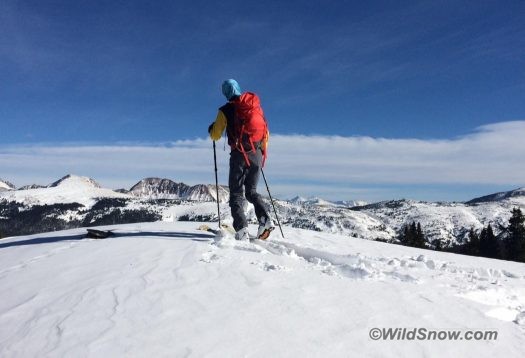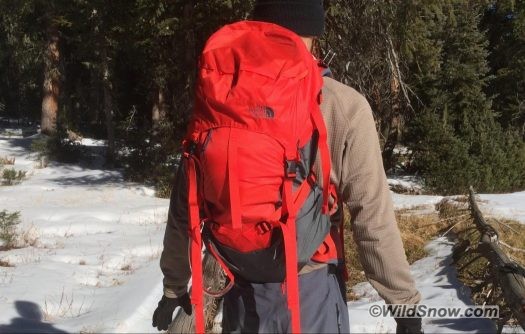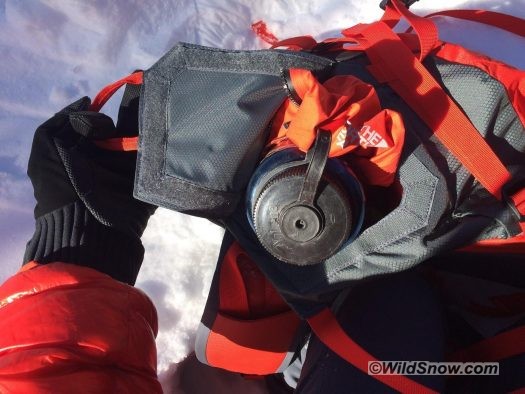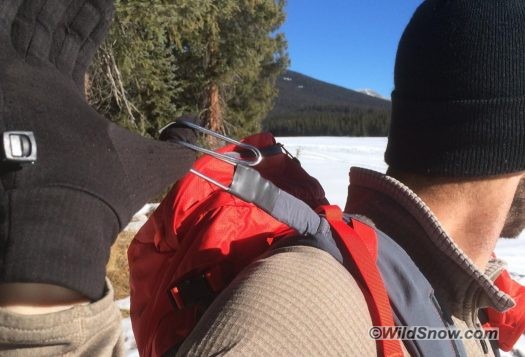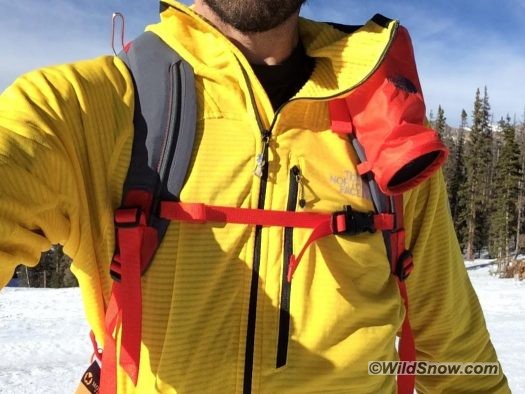Andy Sovick
(This post sponsored by our publishing partner Cripple Creek Backcountry.)
My first ski pack was a frumpy orange hulk of a bag with one top-loading compartment and a “brain” with a beefy zipper. I got it when I was seventeen, and fell in love right away. Nevermind that it always appeared to be sliding off my shoulders like a sleeping toddler in a kid’s pack. This sack received much tongue-in-cheek commentary and judgement from friends and partners. And I loved it. I loved it so much, I skied with it exclusively for 15 years. It was simple (top-loading), big enough for multi-day trips, with enough strap-features to compress to small day tours. It has been loved so much, it has probably achieved Velveteen Rabbit “real” status. I found myself talking to it. Time to move on?
After 16 delightful years with my rust colored relic, I finally buckled and got an airbag ski pack, repurposing the orange relic as an elk hunting tool. I have been very happy with my new airbag pack, since I’m part of the camp that believes in using tools that have a real possibility of saving a life in the event of an avalanche.
But, what about ski touring when I don’t need an airbag? I spend well over half the season on light, low-angle tours, or spring trips in highly predictable conditions. In these cases, I’d rather have something simpler and lighter weight, a bag like Trusty ol’ Orange.
Therefore, I’ve been on the prowl for a pack to fill the gap, but a guy can be mighty discerning when he’s comparing everything to his first love (am I right guys? Ladies?). Before I let the metaphors run away, I better review some gear. WildSnow got a North Face Proprius 38 ski touring pack, I volunteered. This pack is part of the “Summit Series” from The North Face, and is made specifically for ski mountaineering.
A minimalist pack, this is not. Which is why it’s impressive to see the Proprius weighing in at 42 oz. In other words, its features-to-weight ratio is impressive. A plus for me is the lack of multiple zippers and compartments. The one compartment “option” that is included in this pack has me feeling like I could compromise (just this once). The “skin and crampon pocket” which is located on the bottom of the pack, is accessible by a velcro side-entry door. Not a new concept, and one that’s liked and reviled by perhaps a 50/50 split in the ski touring population.
This bottom compartment is much like the sleeping bag compartment found in many summer backpacking rigs. It is intended for crampons and skins (or perhaps a “rando” rope stowed for quick access). Moisture stays separate and accessories can be reached without taking off the pack. Since I have not gone on a crampon-style tour with this pack yet, I have happily stored a large water bottle in this compartment along with my skins. I’ve begun to get spoiled by quick access to the water bottle, mid-stride, without removing any straps on my pack. I also experimented with a shell, puffy, and snacks in the bottom compartment, but ultimately I think the skins are better off in there.
If you’re a “one-compartment-only” purist (like I tend to be), you can open an internal zipper to make the Proprius into a one-compartment pack (this could be scissored out permanently, WildSnow style). The brain can be removed via a reversible buckle system, which would further downsize and simplify, bringing the base-weight down to 38 ounces.
I like the bottom chamber, but I do question the functionality of the velcro closure over the long-term. I am, after all, interested in a permanent relationship with a top-loading pack. If the velcro began to fatigue, I’d start looking for DIY rigs to ensure the flap stays shut. As many of you know, this type of velcro flapped lower compartment is not a new concept; it was probably first implemented by Dynafit quite some time ago. Some folks find it relatively useless, others do agree that the velcro can be problematic and suggest immediately adding a “safety” clip of some sort to prevent catastrophic loss of essential gear. If we do a long term use review, I’ll include ideas about that.
Other key features: The diagonal ski carry loop and hook is designed for quick deployment without taking off your pack. The bottom loop looks big and in the way at first, but it still hasn’t bothered me yet. I’ve used it with my Romp 96mm boards, and my 80mm racing skis. Both have slid into, and held tightly within this system. Thumbs up with a caveat. As with many lightweight ski rucksacks, Proprius 38 has no protection against your ski edges, careful packing is required. Those who carry strapped skis for hours on end may need to add extra fabric, or wrap an extra item of clothing around the skis where they friction the pack.
There is a water bladder sleeve inside the pack. I don’t like water bladders anymore, as I’ve had too many incidents over the years with leaks, freezing parts, and moldy floaties. Water bottles work just fine for me. If you prefer a bladder, then this sleeve will work well, along with a velcro loop on top to minimize flopping. I would rather The North Face traded this water sleeve out for a sleeve that would swallow up my shovel blade, handle and probe (I tried to jam it in, but it’s too narrow for the blade, and too shallow for the probe). For now I have to stick to my old system of tucking the probe, saw, and shovel parts into the main compartment corners. But I might soon be inclined to fashion my own shovel/probe sleeve into this pack, if our relationship is otherwise going smoothly.
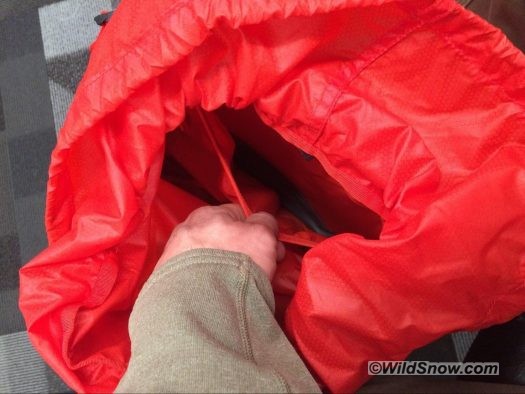
In front is an adjustable sternum strap with a whistle and an insulated water bottle holder on the shoulder strap. I removed this holder after one day with it, but I know some people like these. Two drawstrings close the top function smoothly, with a strap/buckle to top it off. Two axe holders work well, and appear to be strong enough.
Conclusion. A feature-filled ski specific top loader? Designers at The North Face decorated this pack with just enough features to make it interesting and kind of fun, but I’d still call it simple (e.g., lack of gear loops and waist belt pouches), and up for a long life in the elements. The easy access velcro door to the bottom is innocent until proven guilty in regards to longevity, so I can’t say it’s a bad idea just yet; besides, I like it! I don’t need to see a dedicated compartment with straw sized organized sleeves for avalanche rescue gear, but I sure wish this pack had a simple tool sleeve. It is, after all, intended specifically for ski mountaineering. Let’s see some attention to avalanche rescue.
My big praise for this pack is for its comfort — a somewhat personal thing as different packs seem to fit different people for better or worse — but it my case better. I’ve loaded it down for a three day hut trip, a full day one-way tour, for simple morning tours, and even simpler resort uphills. No matter what, the pack is comfortable. Does it replace Trusty ol’ Orange? Only time will tell. If you see me waxing nostalgic about it on WildSnow in 16 years, then you’ll have your answer of whether it found its way into my heart. Until then, it’s found a place on my back for a long term test.
Proprius 38 will be available fall of 2018.
(WildSnow guest blogger Andy Sovick is the founder and owner of Off-Piste Ski Atlas. A self-professed map-geek, Andy has been skiing Colorado’s backcountry his entire life. Raised on cross-country skis pulled from a dumpster in Fort Collins, he started his ski career following his parent’s tracks along Cameron Pass. Having perfected the classic wobbly telemark turn, and subsequent telemark face-plant, he moved to Durango, where he graduated from Fort Lewis College in Durango. He now resides with his wife and son in Gunnison, Colorado.)
Beyond our regular guest bloggers who have their own profiles, some of our one-timers end up being categorized under this generic profile. Once they do a few posts, we build a category. In any case, we sure appreciate ALL the WildSnow guest bloggers!

